engine RENAULT SCENIC 2014 J95 / 3.G Petrol Injection - Sagem3000 Workshop Manual
[x] Cancel search | Manufacturer: RENAULT, Model Year: 2014, Model line: SCENIC, Model: RENAULT SCENIC 2014 J95 / 3.GPages: 181
Page 151 of 181

PETROL INJECTION
Fault finding – Interpretation of statuses17B
17B - 151V12 MR-372-J84-17B000$540.mif
SAGEM 3000
Program No.: A7
Vdiag No.: 44, 48
ET415
(CONTINUED 4)
STATUS 10Monitoring by injection computer
Status ET415 becomes STATUS 10 when driving with cruise control active (ET042
Cruise control/speed limiter: CRUISE CONTROL) if the injection computer detects a
fault anywhere in the engine management system, or an engine speed that is too high
or too low.
This signal is conveyed on the multiplex line and deactivates the cruise control.
Carry out a multiplex network test, then run fault finding on the injection computer.
Deal with present or stored faults (see Interpretation of faults).
Reinitialise status ET415 on the injection computer by running command RZ007
“Fault memory”.
If status 10 continues, contact the Techline.
AFTER REPAIRDeal with any other faults. Clear the fault memory.
Switch off the ignition and carry out a road test followed by a test with the diagnostic
tool.
1JSAA741.0
Page 156 of 181

PETROL INJECTION
Fault finding – Parameter summary table17B
17B - 156V12 MR-372-J84-17B000$630.mif
SAGEM 3000
Program No.: A7
Vdiag No.: 44, 48PETROL INJECTION
Fault finding – Parameter summary table
*OCR: Opening cycle ratioTool parameter Diagnostic tool title
PR001Advance
PR010Idle speed regulation setpoint
PR014Idling speed correction
PR015Engine torque
PR018Estimated air flow
PR028Pedal position (gang 1)
PR029Pedal position (gang 2)
PR030Accelerator pedal position
PR032Inlet pressure
PR035Atmospheric pressure
PR037Refrigerant pressure
PR041Turbocharging pressure
PR055Engine speed
PR058Air temperature
PR064Coolant temperature
PR071Computer feed voltage
PR089Vehicle speed
PR090Idle speed regulation programming value
PR091Theoretical idle speed regulation OCR
PR095Anti-pinking correction
PR096Motorised throttle upper stop programmed value.
PR097Motorised throttle lower stop programmed value.
PR098Upstream oxygen sensor voltage
PR099Downstream oxygen sensor voltage
PR100Torque lapse
PR101Duration of injection
PR102Canister bleed solenoid valve OCR*
JSAA741.0
MR-372-J84-17B000$630.mif
Page 157 of 181

PETROL INJECTION
Fault finding – Parameter summary table17B
17B - 157V12 MR-372-J84-17B000$630.mif
SAGEM 3000
Program No.: A7
Vdiag No.: 44, 48
*OCR: Opening cycle ratio
*AT: automatic transmission
*SV: Solenoid valveTool parameter Diagnostic tool title
PR103Instantaneous fuel consumption
PR105OBD fault warning light lit mileage counter
PR106Mileage counter fault warning light lit
PR111Motorised throttle position corrected value.
PR112No load programmed value
PR113Lower throttle stop after applying offset
PR116Motorised throttle corrected position setpoint
PR118Measured throttle position gang 1
PR119Measured throttle position gang 2
PR122Torque received by AT* converter
PR123Estimated driver demand engine torque
PR124Resistant engine torque transmitted via multiplex line
PR125Power absorbed by the air conditioning compressor
PR127Heating resistor max. authorised power
PR130Cruise control setpoint.
PR138Richness correction
PR141Integral idling speed regulation correction
PR143Self-adapting richness gain
PR144Self-adapting richness offset
PR846Turbocharging solenoid valve opening cycle ratio
JSAA741.0
Page 162 of 181
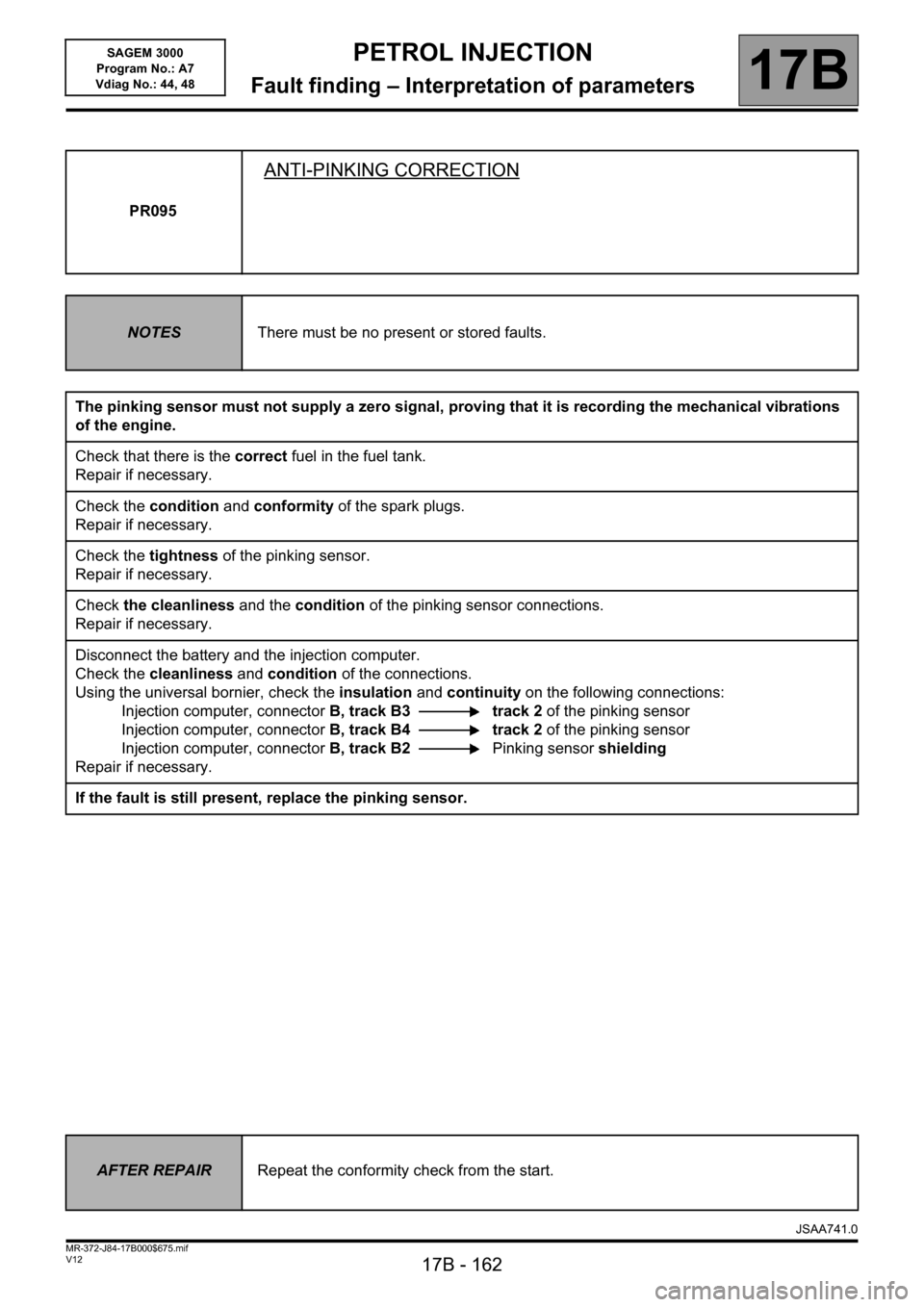
PETROL INJECTION
Fault finding – Interpretation of parameters17B
17B - 162V12 MR-372-J84-17B000$675.mif
SAGEM 3000
Program No.: A7
Vdiag No.: 44, 48
PR095
ANTI-PINKING CORRECTION
NOTESThere must be no present or stored faults.
The pinking sensor must not supply a zero signal, proving that it is recording the mechanical vibrations
of the engine.
Check that there is the correct fuel in the fuel tank.
Repair if necessary.
Check the condition and conformity of the spark plugs.
Repair if necessary.
Check the tightness of the pinking sensor.
Repair if necessary.
Check the cleanliness and the condition of the pinking sensor connections.
Repair if necessary.
Disconnect the battery and the injection computer.
Check the cleanliness and condition of the connections.
Using the universal bornier, check the insulation and continuity on the following connections:
Injection computer, connectorB, track B3 track 2 of the pinking sensor
Injection computer, connectorB, track B4 track 2 of the pinking sensor
Injection computer, connectorB, track B2Pinking sensor shielding
Repair if necessary.
If the fault is still present, replace the pinking sensor.
AFTER REPAIRRepeat the conformity check from the start.
JSAA741.0
Page 164 of 181

PETROL INJECTION
Fault finding – Interpretation of parameters17B
17B - 164V12 MR-372-J84-17B000$675.mif
SAGEM 3000
Program No.: A7
Vdiag No.: 44, 48
PR098
CONTINUED
If the idle speed is not stable, check:
– the timing adjustment,
– the hydraulic tappets if there is camshaft noise (seeMR 364 Mechanical, 11A, Top and front of engine),
– the cylinder compression's.
Drive the vehicle to check the repair.
AFTER REPAIRRepeat the conformity check from the start.
JSAA741.0
Page 167 of 181
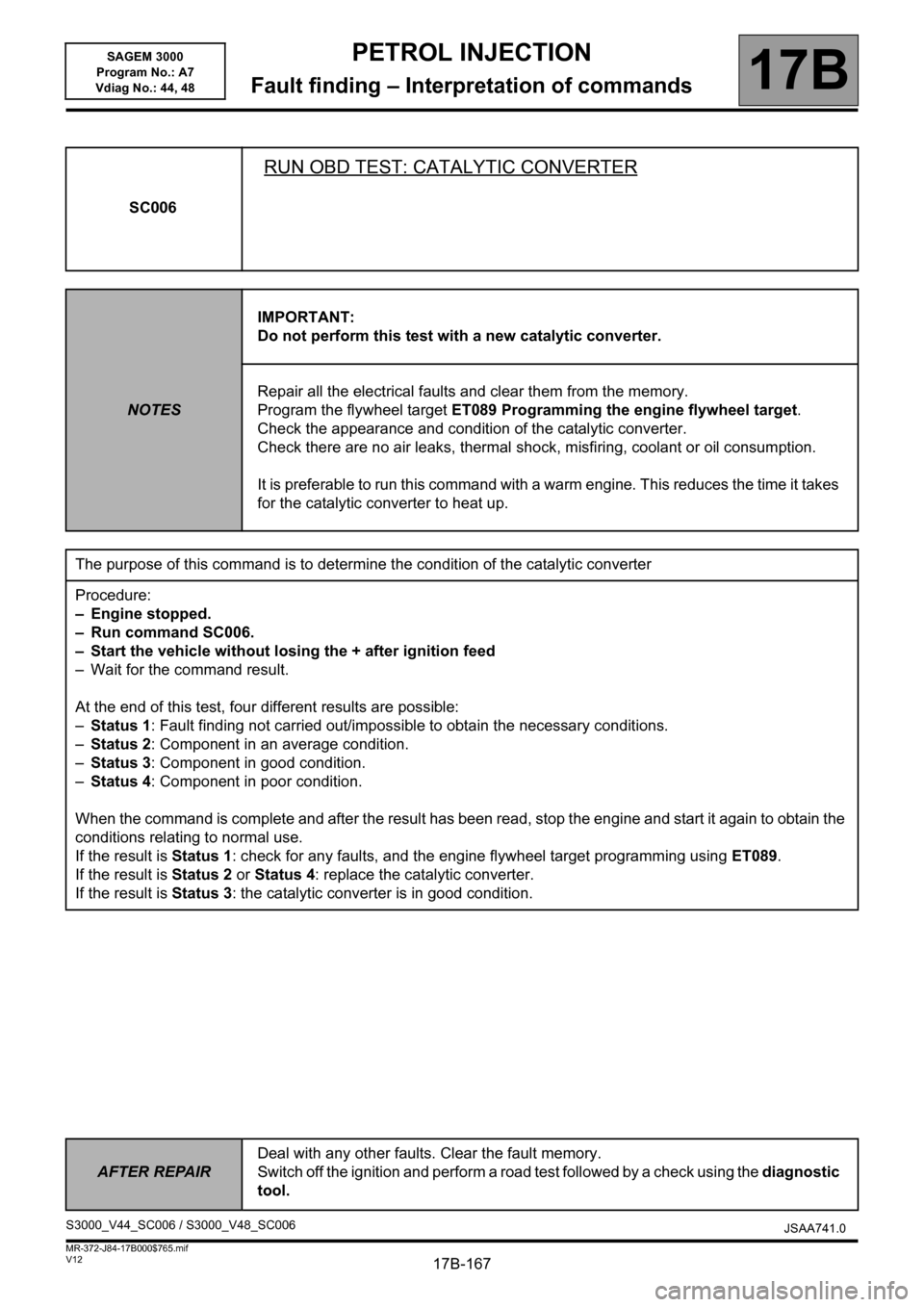
17B-167
AFTER REPAIRDeal with any other faults. Clear the fault memory.
Switch off the ignition and perform a road test followed by a check using the diagnostic
tool.
V12 MR-372-J84-17B000$765.mif
17B
SAGEM 3000
Program No.: A7
Vdiag No.: 44, 48
SC006
RUN OBD TEST: CATALYTIC CONVERTER
NOTESIMPORTANT:
Do not perform this test with a new catalytic converter.
Repair all the electrical faults and clear them from the memory.
Program the flywheel target ET089 Programming the engine flywheel target.
Check the appearance and condition of the catalytic converter.
Check there are no air leaks, thermal shock, misfiring, coolant or oil consumption.
It is preferable to run this command with a warm engine. This reduces the time it takes
for the catalytic converter to heat up.
The purpose of this command is to determine the condition of the catalytic converter
Procedure:
– Engine stopped.
– Run command SC006.
– Start the vehicle without losing the + after ignition feed
– Wait for the command result.
At the end of this test, four different results are possible:
–Status 1: Fault finding not carried out/impossible to obtain the necessary conditions.
–Status 2: Component in an average condition.
–Status 3: Component in good condition.
–Status 4: Component in poor condition.
When the command is complete and after the result has been read, stop the engine and start it again to obtain the
conditions relating to normal use.
If the result is Status 1: check for any faults, and the engine flywheel target programming using ET089.
If the result is Status 2 or Status 4: replace the catalytic converter.
If the result is Status 3: the catalytic converter is in good condition.
S3000_V44_SC006 / S3000_V48_SC006
JSAA741.0
PETROL INJECTION
Fault finding – Interpretation of commands
Page 168 of 181
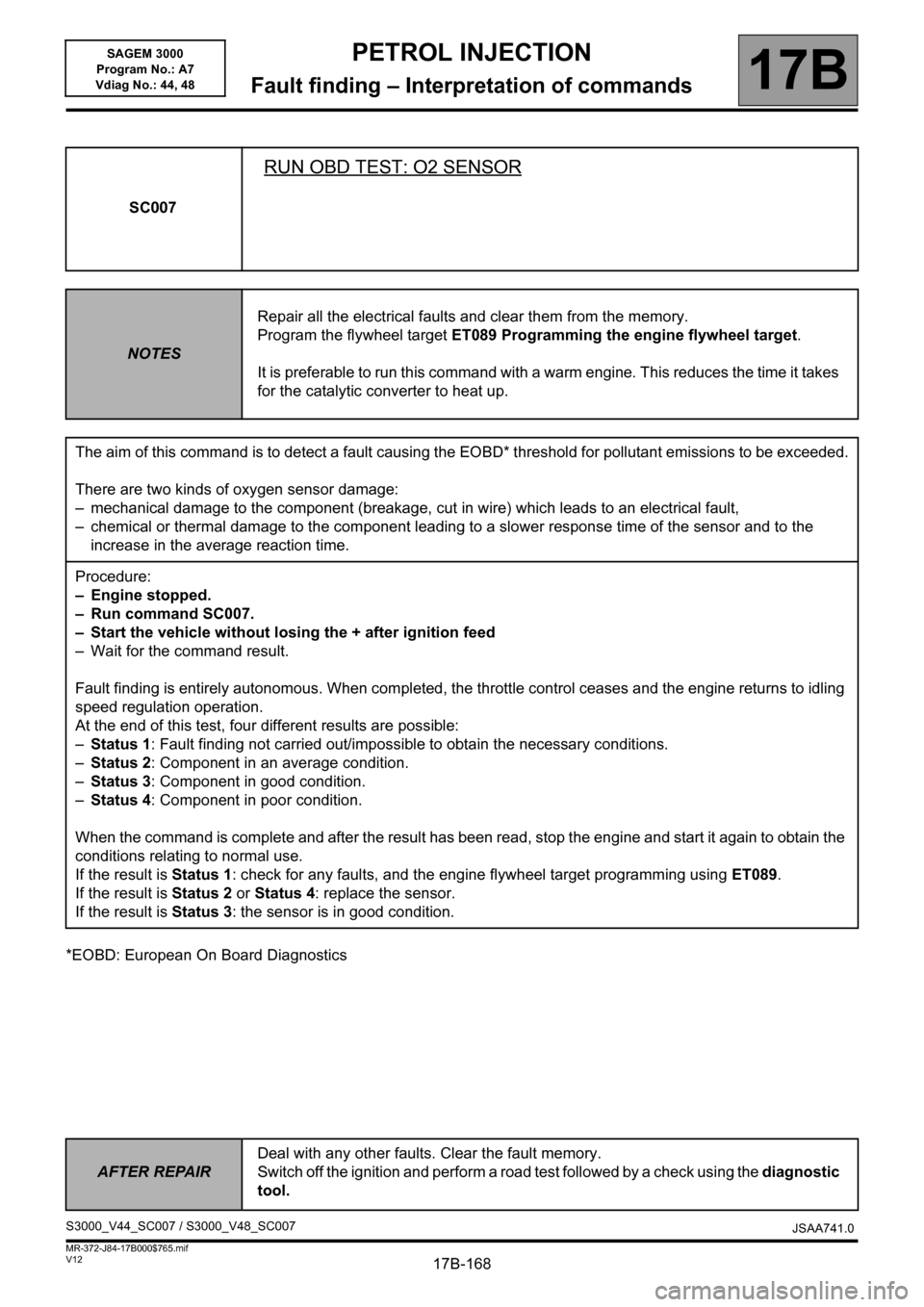
17B-168
AFTER REPAIRDeal with any other faults. Clear the fault memory.
Switch off the ignition and perform a road test followed by a check using the diagnostic
tool.
V12 MR-372-J84-17B000$765.mif
PETROL INJECTION
Fault finding – Interpretation of commands17B
SAGEM 3000
Program No.: A7
Vdiag No.: 44, 48
*EOBD: European On Board DiagnosticsSC007
RUN OBD TEST: O2 SENSOR
NOTESRepair all the electrical faults and clear them from the memory.
Program the flywheel target ET089 Programming the engine flywheel target.
It is preferable to run this command with a warm engine. This reduces the time it takes
for the catalytic converter to heat up.
The aim of this command is to detect a fault causing the EOBD* threshold for pollutant emissions to be exceeded.
There are two kinds of oxygen sensor damage:
– mechanical damage to the component (breakage, cut in wire) which leads to an electrical fault,
– chemical or thermal damage to the component leading to a slower response time of the sensor and to the
increase in the average reaction time.
Procedure:
– Engine stopped.
– Run command SC007.
– Start the vehicle without losing the + after ignition feed
– Wait for the command result.
Fault finding is entirely autonomous. When completed, the throttle control ceases and the engine returns to idling
speed regulation operation.
At the end of this test, four different results are possible:
–Status 1: Fault finding not carried out/impossible to obtain the necessary conditions.
–Status 2: Component in an average condition.
–Status 3: Component in good condition.
–Status 4: Component in poor condition.
When the command is complete and after the result has been read, stop the engine and start it again to obtain the
conditions relating to normal use.
If the result is Status 1: check for any faults, and the engine flywheel target programming using ET089.
If the result is Status 2 or Status 4: replace the sensor.
If the result is Status 3: the sensor is in good condition.
S3000_V44_SC007 / S3000_V48_SC007
JSAA741.0
Page 173 of 181
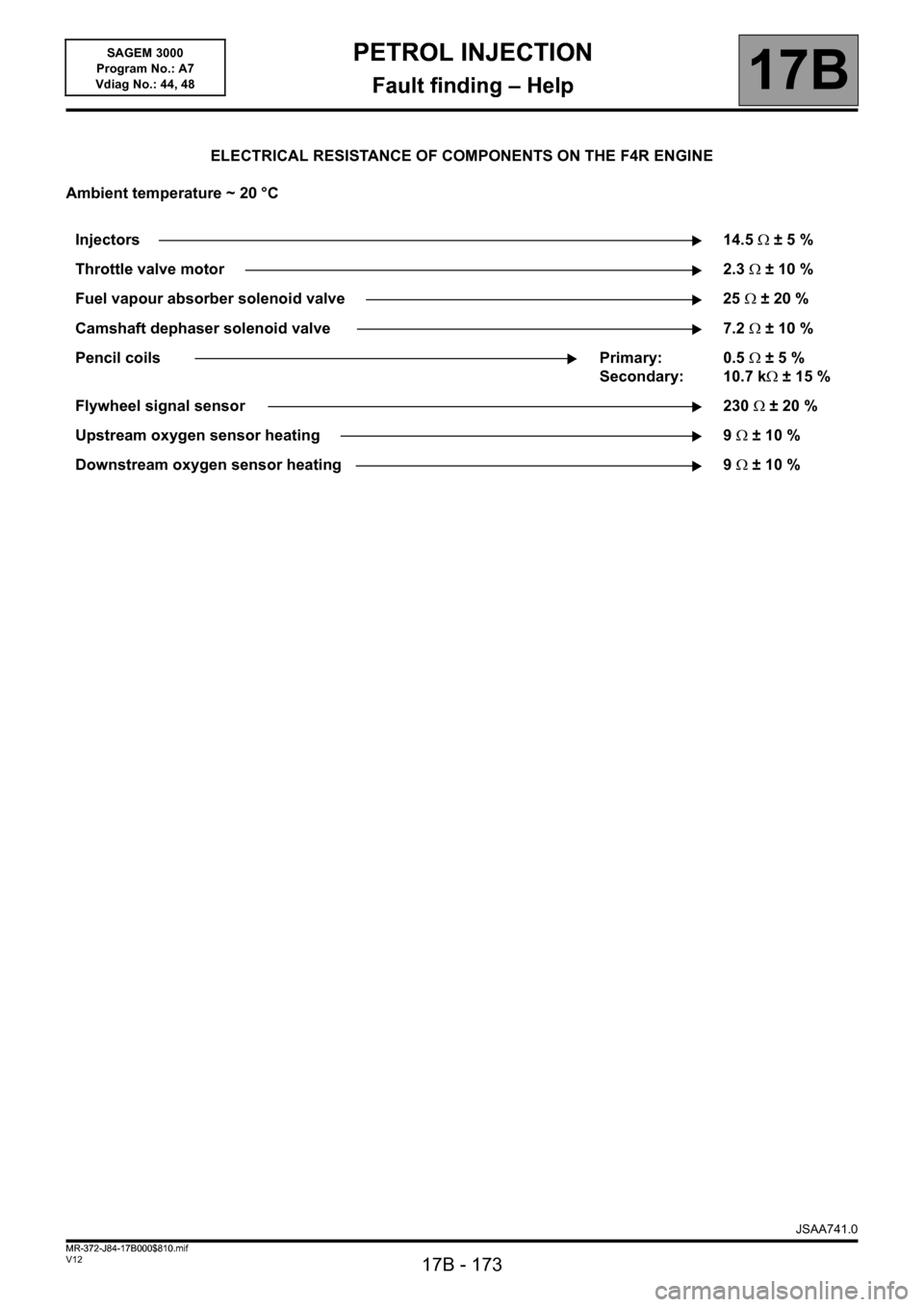
PETROL INJECTION
Fault finding – Help17B
17B - 173V12 MR-372-J84-17B000$810.mif
SAGEM 3000
Program No.: A7
Vdiag No.: 44, 48PETROL INJECTION
Fault finding – Help
ELECTRICAL RESISTANCE OF COMPONENTS ON THE F4R ENGINE
Ambient temperature ~ 20 °C
Injectors14.5 ±5%
Throttle valve motor2.3 ±10%
Fuel vapour absorber solenoid valve 25 ±20%
Camshaft dephaser solenoid valve 7.2 ±10%
Pencil coils Primary:
Secondary: 0.5 ±5%
10.7 k ±15%
Flywheel signal sensor 230 ±20%
Upstream oxygen sensor heating 9 ±10%
Downstream oxygen sensor heating 9 ±10%
JSAA741.0
MR-372-J84-17B000$810.mif
Page 174 of 181

PETROL INJECTION
Fault finding – Help17B
17B - 174V12 MR-372-J84-17B000$810.mif
SAGEM 3000
Program No.: A7
Vdiag No.: 44, 48
F4R ENGINE
Values for components with variable electrical resistance:
AIR TEMPERATURE SENSOR
DAV IATS 04 - PIE 7700101451 B
Temperature in °C Electrical resistance in
- 40 49930 ± 15 %
- 10 9540 ± 10 %
25 2050 ± 6 %
50 810 ± 6 %
80 309 ± 6 %
110 135 ± 6 %
120 105 ± 6 %
COOLANT TEMPERATURE SENSOR
SYLEA 402114 02 - PIE 7700113867
Temperature in °C Electrical resistance in
- 40 75780 ± 10 %
- 10 12460 ± 10 %
25 2250 ± 5 %
50 810 ± 5 %
80 283 ± 5 %
110 115 ± 5 %
120 88 ± 5 %
JSAA741.0
Page 175 of 181
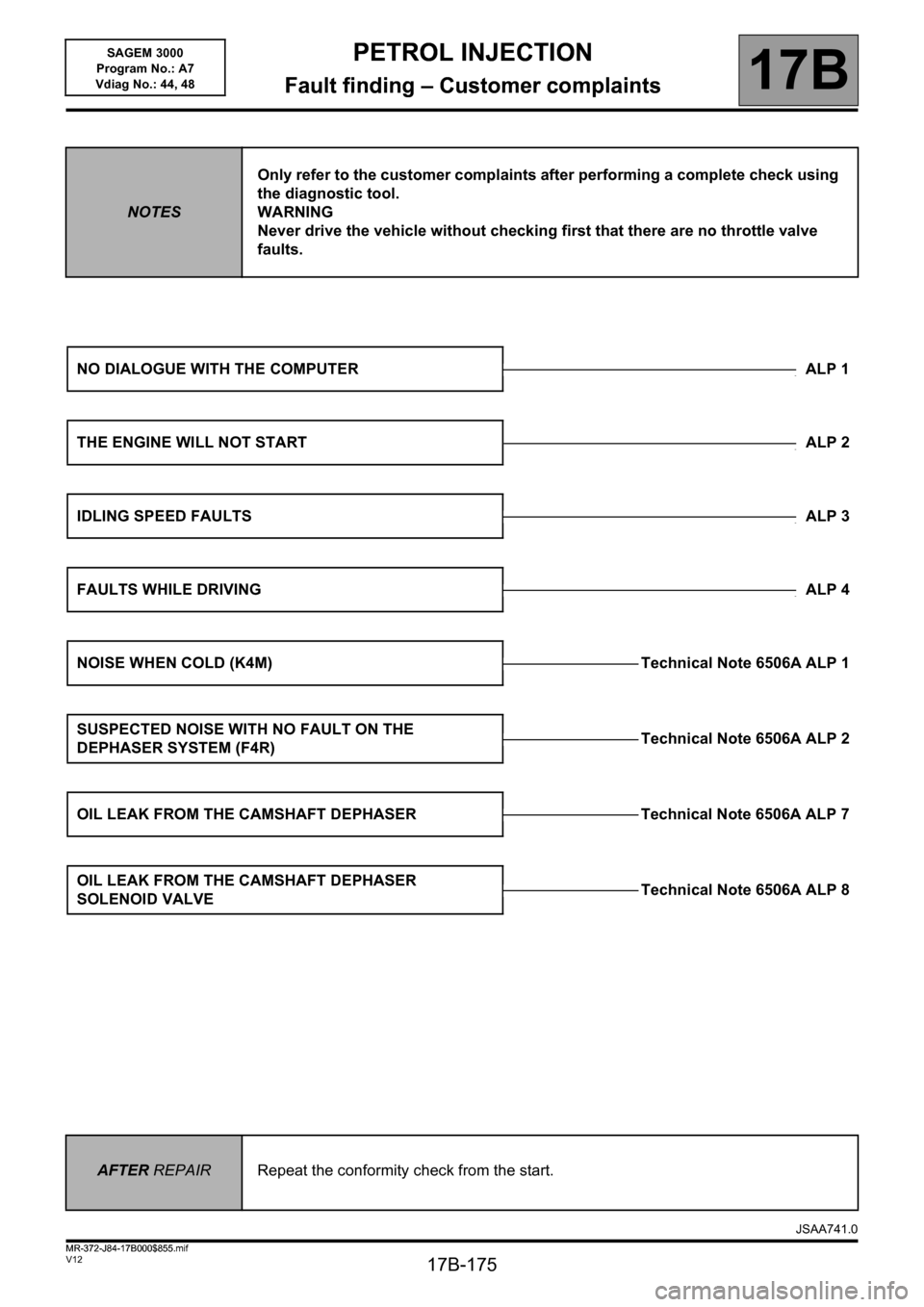
PETROL INJECTION
Fault finding – Customer complaints17B
17B-175V12 MR-372-J84-17B000$855.mif
SAGEM 3000
Program No.: A7
Vdiag No.: 44, 48PETROL INJECTION
Fault finding – Customer complaints
NOTESOnly refer to the customer complaints after performing a complete check using
the diagnostic tool.
WARNING
Never drive the vehicle without checking first that there are no throttle valve
faults.
NO DIALOGUE WITH THE COMPUTER ALP 1
THE ENGINE WILL NOT STARTALP 2
IDLING SPEED FAULTSALP 3
FAULTS WHILE DRIVINGALP 4
NOISE WHEN COLD (K4M) Technical Note 6506A ALP 1
SUSPECTED NOISE WITH NO FAULT ON THE
DEPHASER SYSTEM (F4R)Technical Note 6506A ALP 2
OIL LEAK FROM THE CAMSHAFT DEPHASER Technical Note 6506A ALP 7
OIL LEAK FROM THE CAMSHAFT DEPHASER
SOLENOID VALVETechnical Note 6506A ALP 8
AFTER REPAIRRepeat the conformity check from the start.
JSAA741.0
MR-372-J84-17B000$855.mif